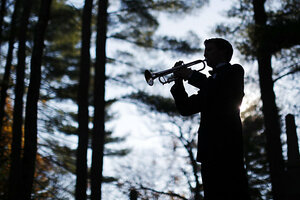Which president signed first Veterans Day proclamation?
The answer to that question about the history of the Nov. 11 holiday is simple and complicated at the same time.

Moses Riley plays 'Taps' during Veterans Day ceremonies in Concord, Mass., Nov. 11, 2014.
Brian Snyder/Reuters
Washington
Which US president was the first to sign a proclamation honoring Veterans Day? The answer to that question about the history of the Nov. 11 holiday is simple and complicated at the same time.
First, the simple part: President Eisenhower issued the first presidential Veterans Day declaration in 1954. He did so because that June, Congress had passed a law establishing Veterans Day.
So Ike, one of the nation’s great military heroes, fulfilled his end of the bargain by calling on US citizens to honor everyone who had ever donned a uniform in defense of their freedoms. At the time he did so, memories of the great inferno of World War II were still fresh around the world.
“Let us solemnly remember the sacrifices of all those who fought so valiantly, on the seas, in the air, and on foreign shores, to preserve our heritage of freedom, and let us reconsecrate ourselves to the task of promoting and enduring peace so that their efforts shall not have been in vain,” said Eisenhower.
The complications arise because Congress did not really establish a new holiday with its Veterans Day legislation. It modified an existing one – Armistice Day.
Armistice Day was first celebrated in the US in 1919 at the direction of President Woodrow Wilson. It honored the end of the previous war to end all wars, World War I.
President Wilson’s original conception was for a day of parades and public meetings, with a moment of silence at 11 a.m. on Nov. 11, the hour and day when the armistice ending the fighting of World War I took effect.
“To us in America, the reflections of Armistice Day will be filled with solemn pride in the heroism of those who died in the country’s service,” said Wilson at the time.
Congress passed a concurrent resolution in 1926 that set aside Veterans Day as a commemoration of the end of World War I. In 1938, lawmakers went one better and voted to make Armistice Day an official legal holiday. At that time it was primarily for World War I veterans, and to honor the cause of furthering world peace.
But world peace did not hold, of course. World War II intervened. It was closely followed by the Korean conflict. It seemed appropriate that Armistice Day morph into something more inclusive and general.
So in 1954 Congress struck “Armistice” from the holiday’s enabling law, replacing it with “Veterans.” Today’s commemoration was born.

